Maximizing Kitchen Space with a 32 Inch Island


Intro
In today's kitchen design, the role of a kitchen island cannot be overstated. A 32 inch wide kitchen island stands out for its balance between functionality and space efficiency. These islands serve various purposes that make them an essential feature in contemporary homes. As we explore the advantages and design elements directly related to this specific size, we uncover the underlying significance they hold in enhancing not only the aesthetics but also the functionality of kitchens.
This article will cover important aspects such as design inspirations, entertaining ideas, and practical considerations when integrating a 32-inch island into your kitchen layout. The format will cater to homeowners and individuals interested in optimizing their culinary spaces, particularly focusing on the benefits this specific dimension offers.
Design Inspiration
Current Interior Design Trends
In current trends, the kitchen island has emerged as a centerpiece within the home. A 32-inch wide island strikes an optimal balance for smaller kitchens or for those desiring a more modest footprint. It can effortlessly blend into various design themes—whether modern, farmhouse, or minimalistic.
Most importantly, there is a growing trend toward multifunctional spaces. Homeowners increasingly prefer islands that serve as cooking zones, dining areas, and social hubs. With an island of this size, it's possible to accommodate a prep sink or an induction cooktop without overwhelming the space. The island can also feature bar stools, providing casual dining options that encourage family interaction.
Color Palettes and Their Effects
Choosing the right color palette for your kitchen island is pivotal. Soft neutral tones such as whites and grays can create a calm ambiance, while darker shades like deep navy or forest green can introduce a touch of drama and sophistication.
When selecting a color, consider how it complements existing cabinetry and countertops. For example, a white island against darker cabinetry can visually brighten the space, whereas rich colors can draw attention and create a cohesive look within more traditional kitchens.
The use of accents, like a bright tile backsplash or a bold countertop material, can also enhance the overall design without overshadowing the island’s role. Balance is key; ensuring that the appearance is integrated yet distinct helps maintain flow within the kitchen.
Entertaining Ideas
Themed Party Concepts
Kitchen islands maximize social opportunities, making them ideal for hosting events. With a 32-inch island, you can organize themed parties with ease. Consider options like a taco bar, which allows guests to personalize their meals while encouraging mingling.
Another popular concept is a wine and cheese night where the island can display an array of selections. Keeping cooking simple and interactive foster a relaxed environment conducive to conversation.
Menu Planning and Recipes
Among the benefits of a kitchen island is its ability to facilitate kitchen operations during entertaining. When preparing a menu, consider dishes that can be prepared in stages. Use the island for tasks like slicing and serving. Dishes such as charcuterie boards can find a perfect display on the island, providing a visual feast that is easy for guests to access.
Planning a menu closely aligns with the island’s setup. Ensuring there is adequate space for serving and mingling is essential—it allows for seamless transitions from cooking to entertaining. Invest in functional kitchen tools that enhance the island's utility while enriching your hosting experience.
"A well-designed kitchen island can optimize space, reinforce style, and serve as a centerpiece for social gatherings."
Preamble to Kitchen Islands
The kitchen island is much more than just an additional surface in the kitchen. It serves as a focal point where functionality meets design. An island allows homeowners to maximize their kitchen space, improving workflow while fostering social interactions. The significance of kitchen islands can not be understated as they adapt to a range of needs and preferences.
Defining Kitchen Islands
Essentially, a kitchen island is a freestanding piece of furniture that can be used for various purposes. It often includes storage, seating, and countertop space. In a typical setup, kitchen islands provide extra room for food preparation, dining, and even socializing, making them highly versatile elements in the overall kitchen design.
The Role of Kitchen Islands in Modern Homes
In modern homes, a kitchen island enhances the overall aesthetic and practicality of the space. It serves as a central hub for cooking, entertaining, and relaxing. More often, homeowners prefer open-plan layouts where the kitchen, dining, and living areas blend seamlessly. A kitchen island plays a crucial role in maintaining this flow, providing a convenient area for family gatherings and hosting guests.
Kitchen islands are adaptable. They can be customized with various materials, colors, and styles to suit individual tastes. Additionally, they can include essential features like electrical outlets, sinks, or cooktops, further increasing their usability. As such, they contribute significantly to the kitchen dynamics, impacting decisions around layout, aesthetics, and even kitchen efficiency.
"Kitchen islands represent the intersection of style and function, making them essential in modern home design."
In summary, the introduction of kitchen islands showcases their importance, offering insights into their roles and definitions. They are not merely an enhancement; they are vital in creating a functional and inviting kitchen space.
The Advantages of a Inch Wide Kitchen Island
A 32 inch wide kitchen island presents various benefits that enhance both functionality and aesthetics of a kitchen space. This width strikes a balance between a spacious work area and the ability to fit comfortably in different kitchen layouts. It allows for a range of uses, from meal preparation to casual dining. Understanding these advantages helps homeowners make informed design choices.
Space Optimization
Space optimization is crucial in any kitchen design. A 32 inch wide kitchen island provides an efficient use of space without overwhelming the room. This width allows for enough countertop area to perform various tasks, such as cutting vegetables or rolling out dough, without sacrificing walking space.
Moreover, in kitchens with limited size, this width can help maximize usability. The island can double as a preparation area, especially in smaller kitchens where counter space is precious. The design can also include storage options beneath the countertop, utilizing vertical space. This can be in forms of cabinets or open shelves. Here are some considerations on optimizing space:
- Incorporate Multi-functional Features: Include additional storage solutions that can be used efficiently.
- Keep Traffic Flow in Mind: Ensure ample walking space around the island to facilitate movement, preventing congestion.
- Consider Accessibility: A well-placed island can be accessible for all users, enhancing the kitchen's flow.
"A well-designed kitchen island not only provides extra space but also serves as a central hub for activities."
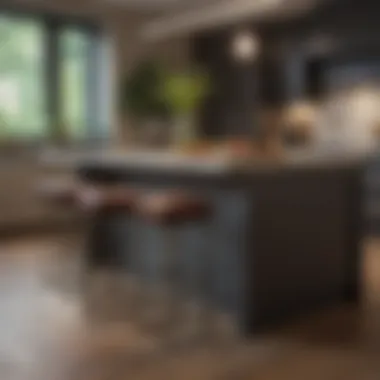
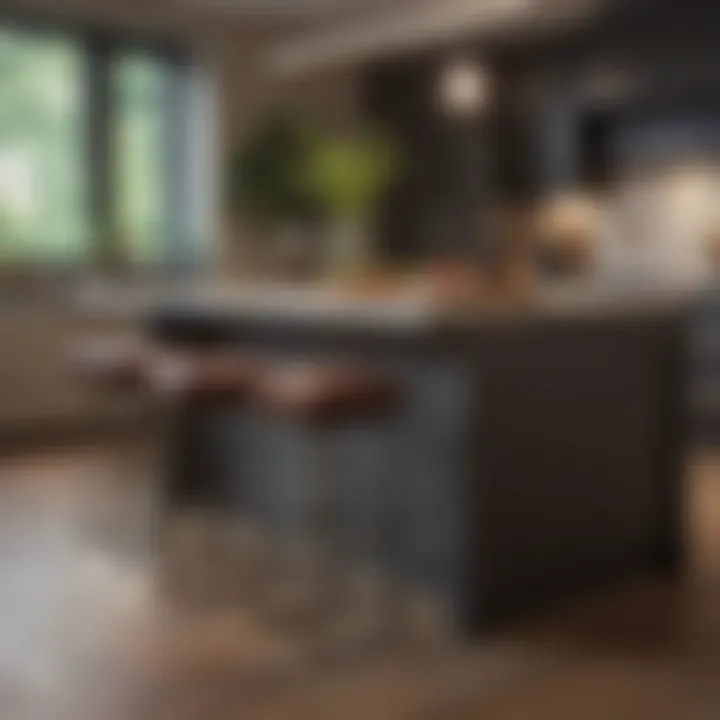
Enhancing Kitchen Workflow
The workflow in a kitchen is essential for cooking efficiency. A 32 inch wide kitchen island enhances this workflow significantly. It allows for better separation of cooking zones. For instance, an island can serve as a dedicated area for meal prep while allowing another zone, like the stove or sink, to remain clear.
The proximity of the island to other kitchen elements further streamlines tasks. One can easily access ingredients, kitchen tools, and appliances arranged nearby. This setup minimizes movement and fosters a more organized cooking experience. Important points about workflow include:
- Create Distinct Zones: Separate areas for preparation and cooking can optimize activities.
- Place Essential Tools Nearby: Keeping utensils and appliances close to the island ensures quick access.
- Plan Layout for Efficiency: The overall kitchen arrangement should support smooth transitions between cooking tasks.
Facilitating Social Interactions
Kitchens are often the heart of a home. A 32 inch wide kitchen island can significantly enhance social interactions. This area provides a gathering spot for family and friends, encouraging participation during meal preparations or casual dining experiences.
Many people prefer kitchens with islands because they offer a more inviting atmosphere. An island can accommodate seating, making it an ideal place for breakfast, snacks, or entertaining guests. Points to consider for social enhancements include:
- Accommodate Seating: Bar stools or low chairs can invite conversation and togetherness.
- Integrate with Dining Spaces: Ensure the island complements existing dining arrangements, making transitions seamless.
- Design for Conversation: An island layout should encourage interaction, positioning it to face the main seating area or appliance.
With its multiple benefits, a 32 inch wide kitchen island represents a thoughtful choice for modern kitchen design. It optimizes space, enhances workflow, and facilitates social connections, making it a valuable asset in any home.
Design Considerations for Kitchen Islands
When planning a kitchen island, several crucial design considerations come into play. These factors not only influence the aesthetics of the island but also its functionality and integration within the kitchen. A well-thought-out island can greatly enhance the entire kitchen experience, making it a hub of activity.
Choosing the Right Width
Selecting the right width for a kitchen island is essential, particularly when dealing with a 32-inch model. A width of 32 inches often strikes a balance between offering usable surface area and remaining practical in smaller kitchens. This dimension allows for plenty of workspace while ensuring that the island does not overwhelm the kitchen.
In addition, width impacts seating arrangements. For instance, a 32-inch island can comfortably accommodate stools on one or two sides, making it ideal for casual meals or socializing during meal prep.
Layout and Placement
The layout and placement of the kitchen island are critical. The island should be positioned to allow for smooth traffic flow between work zones within the kitchen. It is advisable to maintain a clearance of at least 36 inches around the island to ensure ease of movement. Proper placement also considers accessibility to appliances and storage.
When placing a 32-inch kitchen island, evaluate how it interacts with existing cabinetry, countertops, and pathways. An island situated too close to other fixtures may create bottlenecks. A well-planned layout promotes efficiency, making the island a central feature that enhances workflow.
Integrating with Existing Design
An integral part of the design process is aligning the kitchen island with the existing kitchen aesthetic. This includes matching materials, colors, and styles with those already present in the kitchen. For example, if the kitchen features wooden cabinetry, a wood-based island can create a harmonious look. Alternatively, a contrasting material like metal or quartz can act as a statement piece.
This integration extends to functional aspects as well. The island should not only complement the visual design but also serve practical needs. For instance, if the main kitchen design emphasizes modernity, incorporating sleek finishes and contemporary lighting can maintain that theme.
"Design is not just what it looks like and feels like. Design is how it works."
– Steve Jobs
In summary, being mindful of width, layout, and design integration is vital in kitchen island planning. Each aspect contributes to a cohesive layout that aligns with the needs and tastes of homeowners. As such, thoughtful design choices will elevate both the usability and appearance of a 32-inch wide kitchen island.
Material Choices for a Kitchen Island
Selecting the right materials for a kitchen island is crucial for both functionality and aesthetics. Materials directly influence the durability, style, and ease of maintenance. A well-chosen material can transform a kitchen island from a simple workstation into a focal point of the kitchen. The choice of materials can also affect the cost and the overall atmosphere of the space. This section delves into countertop and base material options, providing insights on their benefits and unique features.
Countertop Materials
Granite
Granite is prized for its durability and natural beauty. It adds a touch of luxury to any kitchen. One key characteristic of granite is its heat resistance, making it ideal for cooking areas. The natural variations in color and pattern make each piece unique. However, granite can require periodic sealing to maintain its appearance, which may be seen as a disadvantage if ease of maintenance is a priority for the homeowner.
Quartz
Quartz is an engineered material that combines natural quartz crystals with resins to create a non-porous surface. This makes it highly resistant to stains and scratches. The consistency in color and pattern is a key benefit, providing a wide array of design options. It’s a popular choice for modern kitchens because it requires little maintenance. However, quartz might not withstand high temperatures as well as natural stones like granite, which is something to consider.
Wood
Wood offers a warm and inviting feel to a kitchen island. It can be an excellent choice for those who want a rustic or traditional look. Wood is versatile and can be stained or painted to match the kitchen decor. It is also relatively easy to work with for repairs. A potential downside is that wood can be susceptible to water damage and scratches, requiring regular sealing and care to keep it looking its best.
Concrete
Concrete is a modern material that provides an industrial aesthetic. Its customizable nature allows for unique shapes and finishes to suit any kitchen design. It is known for its strength and durability, which can handle heavy use. One of its unique features is the ability to embed colors or textures during production. However, concrete can crack over time and may require sealing to prevent stains, which could be a drawback for some homeowners.
Base Material Options
Metal
Metal bases, often made from stainless steel or other metals, offer a sleek and contemporary look. Their key characteristic is durability and resistance to heat and moisture, lending themselves well to high-traffic areas. Metal also complements other materials like wood and stone beautifully, creating a contrast that enhances overall kitchen design. However, metal can be prone to scratches and dents, which requires careful handling.
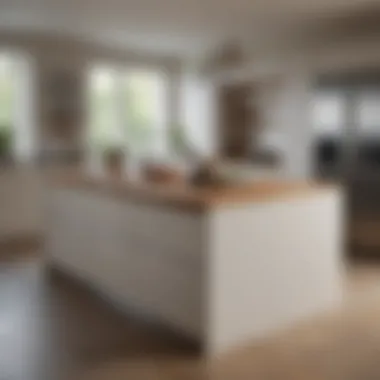
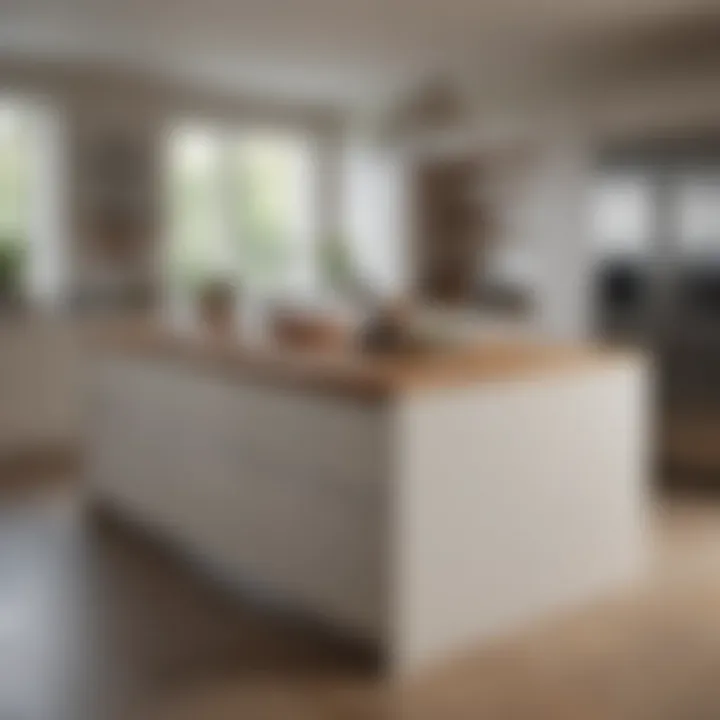
Wood
Similar to its use in countertops, wood bases provide a classic and timeless appearance. They offer warmth and can help to balance out colder materials like granite or metal. The ease of customizing wood is a significant advantage, and it can be painted or stained according to preference. On the downside, wood bases may not withstand moisture exposure as well as other materials, possibly leading to warping or mold.
Laminate
Laminate is a synthetic product that replicates the appearance of wood, stone, or other materials at a lower cost. Its key benefit is versatility, available in countless colors and patterns, catering to various styles. Laminate is easy to clean and maintain. However, it may not have the same durability or resistance to heat and scratches as solid wood or stone, which can limit its appeal for some homeowners.
Choosing the right materials is essential to balancing aesthetics with practicality. Each material has its own strengths and weaknesses, so understanding them is crucial for achieving the desired kitchen island functionality and style.
Functionality Features to Consider
The functionality features of a kitchen island are crucial for maximizing its utility. Homeowners must reflect on what specific needs they hope to address. A 32-inch kitchen island can host various functionalities that include storage solutions, seating options, and integrated appliances. These considerations enhance the overall user experience, making the kitchen more efficient and pleasant for everyday use.
Incorporating Storage Solutions
Cabinets
Cabinets are an essential storage feature in any kitchen island. They provide ample space for stashing kitchenware, pots, and pans, promoting an organized area. A key characteristic of cabinets is their ability to conceal clutter while ensuring easy access to items when needed. This is particularly beneficial in smaller kitchens where space is at a premium. The unique aspect of cabinets is the variety of styles available; from modern, sleek door designs to more traditional options, cabinets can enhance the overall aesthetic of the kitchen. However, one disadvantage is that cabinets can take up valuable space within the island, which may hinder movement.
Shelves
Shelves are another popular storage solution that complements the functionality of kitchen islands. They are easy to access and provide a visible storage option, perfect for displaying cookbooks or decorative items. The primary advantage of shelves is their versatility; they can be designed in various configurations—either open or closed. Shelves can cater to both decorative and functional needs. However, they may not secure items as effectively as cabinets, making it essential to ensure that displayed items are not prone to falling or becoming dusty.
Drawers
Drawers offer a practical approach to storage on a kitchen island. They provide easy access to utensils, cutlery, and other kitchen essentials, making them a popular choice. The key characteristic of drawers lies in their organization capabilities. Many drawers come with dividers, allowing for better management of space. This feature makes it easy to find what one needs quickly. A consideration when using drawers is their depth. Too shallow may limit storage capacity, while deep drawers can be difficult to navigate.
Adding Seating Options
Seating options play a vital role in the functionality of a kitchen island. By integrating seating, an island can function well as a casual dining area or a space for social interaction. Bar stools or chairs can transform an ordinary kitchen island into a focal point for gatherings, thus affecting the overall kitchen dynamics. Homeowners should consider the height of the island and the type of chairs to ensure comfort and alignment.
Installing Appliances
Cooktops
Incorporating cooktops into the kitchen island elevates the cooking experience. They allow for an interactive cooking setup where home cooks can prepare meals while still engaging with family and friends. The primary benefit of installing cooktops is the convenience of cooking in an open area rather than a closed-off space. However, one must consider ventilation and fire safety as operational concerns when placing a cooktop in an island.
Sink Options
Sink options on the kitchen island bring practicality. Not only does it provide a central place for food prep, but it also facilitates cleanup during and after meal preparations. An important characteristic is the convenience that a sink offers, reducing steps around the kitchen. Unique features can include integrated garbage disposals or multiple basins for increased functionality. The downside might be limited counter space surrounding the sink, which could hinder food preparation.
Dishwasher Integration
Integrating a dishwasher into the kitchen island streamlines the cleanup process after meals. A primary advantage is that it places the dishwasher near the sink, minimizing the distance for transferring dirty dishes. This integration is especially beneficial for kitchens that entertain frequently. On the contrary, one should be mindful of plumbing considerations and the need for proper electrical connections when opting for this feature.
Aesthetic Enhancements
Aesthetic enhancements are vital in determining the overall feel and look of your kitchen island. Given that the kitchen is often the heart of the home, its design should reflect personal taste and functionality. By thoughtfully choosing colors, finishes, and accessories, homeowners can create a striking focal point that complements the entire kitchen.
Color and Finish Choices
Choosing the right colors and finishes for a kitchen island can significantly influence the overall ambiance of the kitchen. Lighter colors, such as whites and pastels, can make a space feel larger and airy, which is ideal for smaller kitchens. Conversely, deeper shades like navy blue or forest green can provide a rich contrast, adding sophistication to the room.
In terms of finishes, a smooth matte surface can give a contemporary feel, whereas a glossy finish may add a touch of elegance and luxury. Homeowners should also consider how the island's color and finish will interact with cabinetry and countertops. For a cohesive look, it can be beneficial to select similar tones or complementary shades that create harmony throughout the kitchen.
Lighting Considerations
Lighting plays a crucial role in showcasing the beauty of a kitchen island. Proper lighting can enhance its features and create a warm atmosphere. Pendant lights above the island can serve both functional and aesthetic purposes. They provide focused task lighting while also acting as decorative elements.
Consider the height of the pendant lights to ensure they do not obstruct the view or impede movement. A cluster of smaller pendants can create visual interest, while a single large fixture can make a bold statement. In addition, integrating under-cabinet lighting can illuminate the countertop, highlighting its color and texture while enhancing safety during food preparation.
Accessorizing Your Kitchen Island
Accessorizing your kitchen island is essential for both style and functionality. Unique decorative items can add personality and flair. Items such as vases, fruit bowls, or cookbooks can be displayed to reflect your tastes and interests.
Moreover, practical accessories like cutting boards and attractive storage containers can keep items organized while contributing to the design.
One important aspect is to maintain balance. Avoid clutter by choosing a few statement pieces that draw attention without overwhelming the space. Accessories should enhance the island's function rather than distract from it.

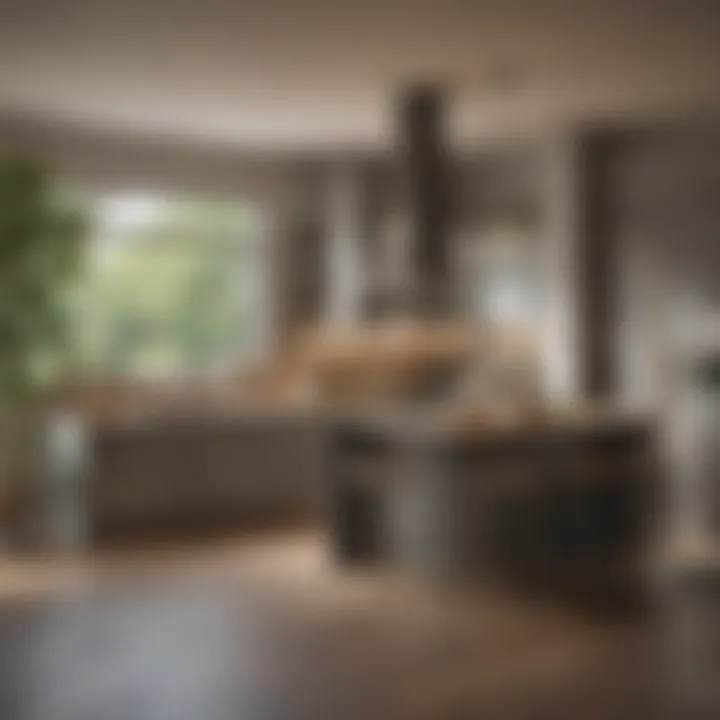
Tip: A well-styled kitchen island can become a conversational piece while serving practical needs.
By judiciously selecting colors, finishes, lights, and accessories, homeowners can ensure their 32-inch wide kitchen island becomes a beautiful and functional centerpiece that reflects their unique style.
Common Mistakes in Kitchen Island Planning
Planning a kitchen island is not merely about aesthetics or style. There are many functional aspects to consider that can significantly impact the overall efficiency and enjoyment of your kitchen space. Recognizing common mistakes in kitchen island planning helps avoid costly changes and ensures the island meets both practical and social needs. Neglecting these factors may result in a design that does not serve its intended purpose, making it essential to investigate the common pitfalls.
Underestimating Space Requirements
One of the most frequent errors is underestimating the space requirements for a kitchen island. A 32 inch wide kitchen island might seem manageable, but without adequate space around it, it can quickly hinder rather than enhance your kitchen layout. When planning, it is crucial to consider the flow and the surrounding workspace.
The recommended clearance around an island should be at least 36 to 48 inches to allow for safe movement, especially when appliances, cabinets, and other kitchen fixtures are in use. Homeowners often miscalculate this space, leading to cramped conditions that disrupt functionality. This mistake can make tasks uncomfortable and may even force individuals to navigate around obstacles, detracting from the kitchen's purpose as a gathering and working point.
Neglecting Functionality
Another notable mistake is neglecting the functionality of the kitchen island. Some homeowners prioritize looks over utility, which can lead to an aesthetically pleasing piece that falls short in practical use. It is important to plan for storage options, seating arrangements, and potential appliance integration as part of the island's design.
For instance, if the island is intended for food preparation, incorporating additional storage for utensils or a designated spot for a cooktop can enhance usability. Furthermore, seating must be planned carefully, ensuring that it is comfortable and accessible while also fitting the overall layout. Without thoughtful consideration of how the island will be used, it may become an underutilized feature rather than the centerpiece of the kitchen.
Ignoring Traffic Flow
Finally, many people fail to address traffic flow in their kitchen design. An island can disrupt the natural pathways if not placed correctly. Ignoring the areas where people move through the kitchen can lead to irritations, especially during gatherings or when cooking with family.
To ensure smooth movement, the placement of the kitchen island should promote an easy flow from the stove, sink, and refrigerator. Utilizing the kitchen triangle principle can be effective in achieving a well-functioning layout. Additionally, consider creating clear paths that can accommodate multiple people cooking or mingling at the same time. A well-thought-out flow not only improves usability but also enhances the overall atmosphere of social interactions.
"Planning a kitchen island successfully involves considering space, functionality, and flow to create an effective and engaging kitchen environment."
By avoiding these common mistakes, homeowners can create a kitchen island that truly enhances their cooking and entertaining experience.
Case Studies of Successful Kitchen Islands
Examining case studies of successful kitchen islands provides valuable insights into how design and functionality can work in harmony. By looking at real examples, homeowners can draw inspiration from both contemporary and traditional styles. These examples highlight the practical benefits, spatial considerations, and aesthetic choices that can enhance any kitchen setting.
Contemporary Designs
Contemporary kitchen islands often emphasize clean lines and minimalistic style. A common feature in these designs is the use of materials like quartz and stainless steel. These materials not only offer durability but also contribute to a sleek look, which is appealing for modern homes.
Some practical elements in contemporary designs include integrated appliances and smart storage solutions. For instance, a kitchen island with a built-in cooktop allows for seamless food preparation while engaging with guests. Additionally, hidden drawers can keep necessary utensils out of sight, maintaining a tidy appearance.
A well-known example of contemporary design is featured in Kitchen Design Magazine where a 32-inch island is paired beautifully in a bright, open-concept space. The island’s height is adjusted slightly higher than standard counters, creating a distinct area for both cooking and socializing.
• Efficiency: Utilizing an island for multi-functional purposes helps in optimizing space. • Integration: Modern islands often blend well with existing kitchen features, enhancing overall design coherence.
Traditional Aesthetics
In contrast, traditional kitchen islands reflect warmth and opulence. These spaces leverage materials like dark wood and granite to invoke a sense of comfort and elegance. Traditional designs often have rich finishes and intricate details, such as carved legs and detailed moldings.
A case study highlighted in Britannica shows a charming farmhouse where a 32-inch island serves as a focal point. Its large surface area allows for ample meal preparation space while also accommodating family gatherings.
The inclusion of open shelving beneath the countertop boosts accessibility and showcases decorative plates or cookbooks. This approach merges functionality with aesthetics, offering both beauty and practicality.
• Warmth: Traditional islands often invite interaction and create a sense of home. • Storage: Creative storage solutions adapt to the style without compromising on function.
Bottom line: Studying these case studies helps homeowners understand how a 32-inch kitchen island can fit into various design paradigms while enhancing utility and style.
Exploring these case studies leads to better decision-making for your kitchen dynamics. By learning from existing designs, one can better conceptualize how a kitchen island can transform a space while reinforcing personal style.
Finale
In this article, the exploration of the 32 inch wide kitchen island reveals its multifaceted role within modern kitchens. This design element stands as a testament to the evolving nature of home interiors, combining practical utility with aesthetic appeal. The significance of the 32 inch width lies in its ability to strike a balance between spaciousness and functionality, making it an optimal choice for various kitchen layouts.
Recap of Key Insights
The primary advantages of a 32 inch wide kitchen island include:
- Space Optimization: Efficiently utilizing kitchen space without overwhelming it.
- Enhanced Workflow: Facilitating smooth movement and access to cooking essentials.
- Social Interaction: Providing a space for family and guests to gather and engage.
These insights underscore the importance of this kitchen feature, offering home owners unique opportunities to revitalize their cooking and entertaining spaces.
Final Thoughts on Inch Wide Kitchen Islands
Considering a 32 inch wide kitchen island can lead to transformative changes in your home. It not only enhances the aesthetics of the kitchen but also improves its functionality. Homeowners should consider their specific needs and the overall kitchen design when opting for such islands.
Ultimately, investing in a kitchen island that is 32 inches wide could be a strategic decision that yields both practical advantages and visual appeal, enhancing the heart of the home. For those embarking on a kitchen renovation or redesign, a careful evaluation of this feature could provide significant value.















